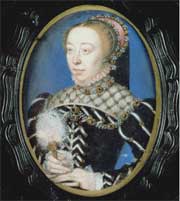Catherine de' Medici
Catherine de' Medici, daughter of Lorenzo II, Duke of Urbino, and Madeleine de La Tour d'Auvergne, Countess of Boulogne, was born in the Palazzo Medici in Florence on the 13th April, 1519. Fourteen years later, on September 1st 1533, Catherine de' Medici gave a farewell banquet to the noble ladies of Florence, and left the city for Porto Venere. There, the French galleys under the command of her uncle, the Duke of Albany awaited her. She was to go to Nice, and then to Marseilles, where she was to marry Henry, Duke of Orléans, second son of Francis I of France. Henry, the future husband of Catherine de' Medici, was fifteen years old.

Portrait of Catherine de' Medici
by François Cluet
Catherine de' Medici - Queen Mother of France
The last day of June 1559, was to be a festive day in Paris, as two royal marriages were celebrated: Philip II of Spain with Elizabeth of France, daughter of King Henry II and Catherine de' Medici, and that of the French King's sister Marguerite, with Emanuel Philibert, duke of Savoy. But, in the tournament held in honor of the occasion, Henry II was wounded by the broken lance of his guard captain, the Scottish knight Montgomery, and died ten days later.
Catherine de' Medici became the Queen Mother when the Religious Civil Wars were about to start. Between 1559 and 1589, France was ruled by the three sons of Henry II. The reign of Francis II lasted from 1559 to 1560; that of Charles IX, his brother, from 1560 to 1574; that of Henry III, a third brother, from 1574 to 1589. During this time there were no less than eight civil wars.
Catherine de' Medici could not stop the ascension of the Guises. The day after Henry II died, in a veritable coup d'état, the Duke of Guise and the cardinal of Lorraine took the persons of Francis II, who was only fifteen, and his wife, Mary Stuart, the niece of the Guises, under their "protection," and conducted them to the Louvre. Before the end of the month, the Duke of Guise was given the war office and the cardinal of Lorraine obtained the finances and the matters of state, while the Bourbon Princes, Coligny and others were given various assignments, well away from Paris, so the Guises were sole leaders of the State.
After the Conspiracy of Amboise failed to overthrow the Guises, Catherine de' Medici, jealous of their position, named Michel de l'Hôpital as Chancellor of France. In May 1560, the royal edict of Romorantin took the jurisdiction of legal processes relating to religion from the regular Law Courts (Parlements) and from lay judges, and remitted them to the ecclesiastical judges. In August, a supplementary decree prohibited the bishops from proceeding against anyone in matters of religion, except the Calvinist preachers or persons in whose houses Huguenot meetings were held. This way, the government tacitly permitted the freedom of conscience to ordinary people. The spirit of this legislation is attributed to the chancellor L'Hôpital, influenced by the Admiral, Gaspard de Coligny, the leader of the Huguenots.
In the summer of 1560, from all over France came reports of insurrection. A large scale Huguenot uprising was possible, and Catherine de' Medici seized the opportunity to play the rival parties to her advantage, with the aim to get rid of the Guises.
Catherine de' Medici's duplicity became obvious at the Council of Fontainebleau ( 20 August 1560), where she declared that she does not see the need to use the arms against the Protestants, while secretly instructing Francis II to ask Philip II of Spain for military support in case of civil conflict.
When Francis II died at Orléans on December 5, 1560, and Charles IX, aged ten, followed to the throne, Catherine de' Medici tried to consolidate her regency by approaching Anne de Montmorency, Constable of France. By this move, Catherine de' Medici intended to keep the Guises in check, and even expelled them from government, now organized around the Queen Mother, and the three Bourbon princes: the King of Navarre, the cardinal of Bourbon, and the Prince of Condé.
Catherine de' Medici wanted the coronation done as soon as possible, and she arranged in the Privy Council (March 27, 1561) that she and the King of Navarre should rule jointly, Catherine having exclusive guardianship of the person of Charles IX. Thus, the Duke of Guise ceased to be influential at court.
Catherine de' Medici, the queen who had led a shadowy life during her husband's reign, eclipsed by Henry's mistress, Diane de Poitiers, was now showing the characteristic ability of her family to conduct the public affairs. As Queen Mother, she kept the King under her strict control. She appointed to offices, granted pardon, kept the seal. She had the last word in councils. She opened the letters of the ambassadors and other ministers.
As her ancestors, Catherine de' Medici loved to erect public edifices, and to collect books and works of art like sculptures, paintings, furniture, pottery. She could neither eat nor drink without talking politics. She was fond of good-living, eating much and irregularly, and was addicted to physical exercise, especially hunting.
Catherine de' Medici And The Civil Wars. The main parties involved in the conflict: the Huguenots, and the Catholic League.